—ENGLISH-ANATOMY UNIT 8 (PART : 2) SKIN
SKIN:

INTRODUCTION:
- The skin is the outer covering of the body. It is also called the integumentary system. This is the largest organ or part of our body.
- The total surface area of the skin is about 2 square meters and its thickness is approximately 1 to 2 mm.
Structure Of the Skin:
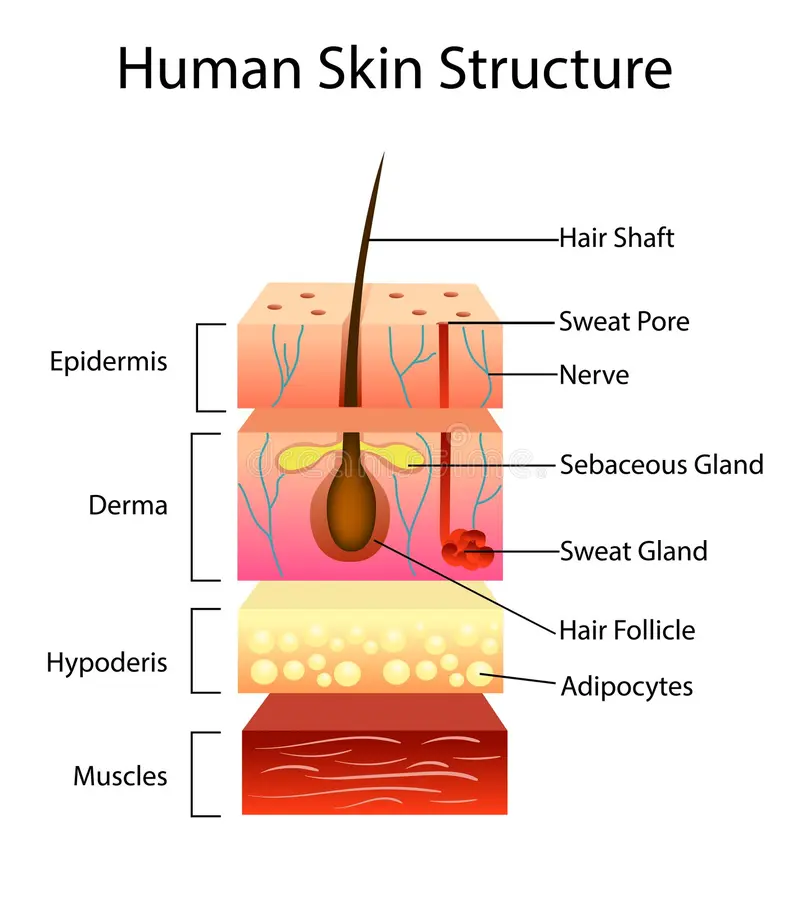
The structure of the skin includes the layers of the skin, the glands in it, the nails and the hair.
Layers of the Skin Skin).

There are mainly three layers of the skin.
1. Epidermis (Epidermis)
2. Dermis (Dermis)
3. Hypodermis (Hypodermis)
1. Epidermis:
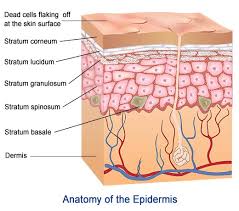
- It is the most superficial and outermost layer of the skin. Its structure consists of stratified columnar epithelium tissue. This layer does not contain blood vessels.
- The epidermis is not evenly distributed in the body. In some places, its thickness is greater, such as the soles of the feet and the palms of the hands. In some places, its thickness is also less, such as the cornea of the eye.
- In the epidermis layer, cells grow from the basement layer and come up to the superficial layer. It takes 35 to 40 days to replace the entire epidermis.
- The epidermis layer consists of the following layers.

A. Stratum Corneum (Stratum Corneum):
- This is the outermost layer of all the layers. In it, dead cells are arranged in a line. These cells are flat and very thin.
- This layer contains keratin. It is a protein. It works to protect the cells inside and prevent them from drying out.
- It maintains the elasticity of the skin and helps to keep it soft.
- This layer is constantly being worn down due to wear and tear from the outside.
B. Stratum Lucidum:
- This layer is also made up of dead and flattened cells. It is also called the block layer because the cells in this layer do not contain water and nuclei.
- This layer contains a protein called lydin. It works to protect the skin from ultraviolet rays coming from the sun.
C. Stratum Granulosum:
- It is called the granulosum layer because of the presence of granules in its cells.
- This layer is 2 to 4 cells thick.
D. Stratum Germinative:
- This layer is the innermost layer of the epidermis.
- This layer periodically produces new cells and these cells move upwards towards the surface. Two types of cells are found here, the prickle cells and the basal cells.
2. Dermis Layer:
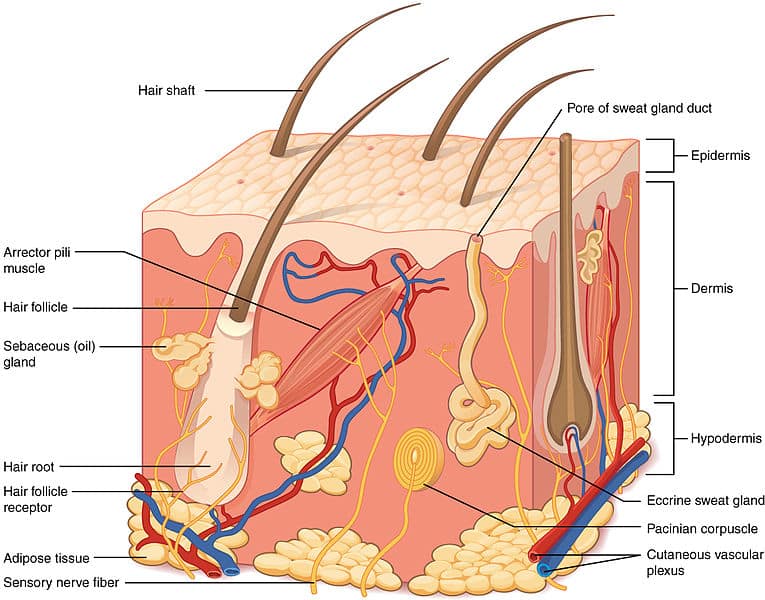
- This layer of skin lies below the epidermis. It contains connective tissue. This layer contains collagen fibers, elastic fibers, and reticular fibers. Due to which the elasticity of the skin is maintained. These fibers strengthen the skin and are very important for providing support.
- The cells in the dermis include fat cells, fibroblasts, and macrophages.
- The dermis layer is made up of a papillary layer and a reticular layer. Both of which are connected to each other, cannot be separated.
- The structure of the dermis layer includes blood vessels, lymph vessels, hair follicles, sensory nerve endings,
- Sweat glands, sebaceous glands, etc.
3. Hypodermis Layer:
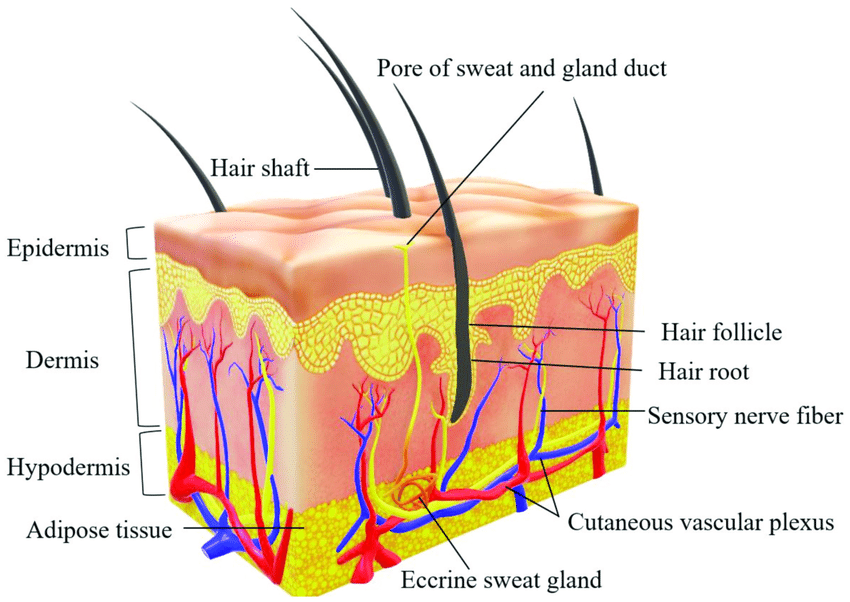
- This layer lies below the dermis layer. It is also called the subcutaneous layer.
- This layer is made up of loose fibrous connective tissue. It is thicker than the dermis. It contains blood vessels, lymph vessels, and nerves.
Functions of the Skin.

- The skin forms a continuous covering around the outside of the body, acting as the first line of protection.
- Prevents microorganisms from directly entering the body.
- Prevents any external injury or harmful elements from entering the body.
- It plays a very important role in maintaining normal body temperature.
- The skin provides the body with an outer framework. It is the largest organ in the body. It covers all the organs on the outside and therefore gives shape to the body.
- It synthesizes vitamin D in the body. In which the skin contains a chemical called seven-dihydrocholesterol. Which converts the ultraviolet rays coming from the sun into vitamin D3 and cholecalciferol. Thus, it functions to synthesize vitamin D.
- The skin also functions to excrete waste products and harmful substances from the body. It also excretes some waste products from the body through the secretion of perspiration.
- Absorption of some substances also occurs through the skin. This is also a route for medication. In which the skin absorbs some ointments and medicines applied to it and sends them to the systemic circulation.
- The skin contains sensory nerve endings. Which help in transmitting impulses like touch, temperature and pain to the brain. This allows us to interpret each stimulation.
- The skin also serves as a storage for some nutrient materials such as fat.
- The skin plays an important role in wound healing.
Skin color (skin color):

- The color of the skin depends on the amount of melanin present in the skin. This melanin is secreted by melanocyte cells located in the stratum basale, a deep layer of the skin. Which determines the color of the skin and the pigmentation of the skin.
- Melanin is present everywhere in the skin, but it is more abundant in the genital area, nipples, underarms, etc. and due to this, these areas appear dark in color.
- People with dark skin color have more melanin than light or fair-skinned people.
Sweat glands (sweat Gland):

There is a lump-shaped gland in the dermis layer of the skin. It is called a sweat gland. Sweat glands in the body secrete a transparent, colorless fluid called sweat. This process is called perspiration.
Two types of sweat glands are mainly found.
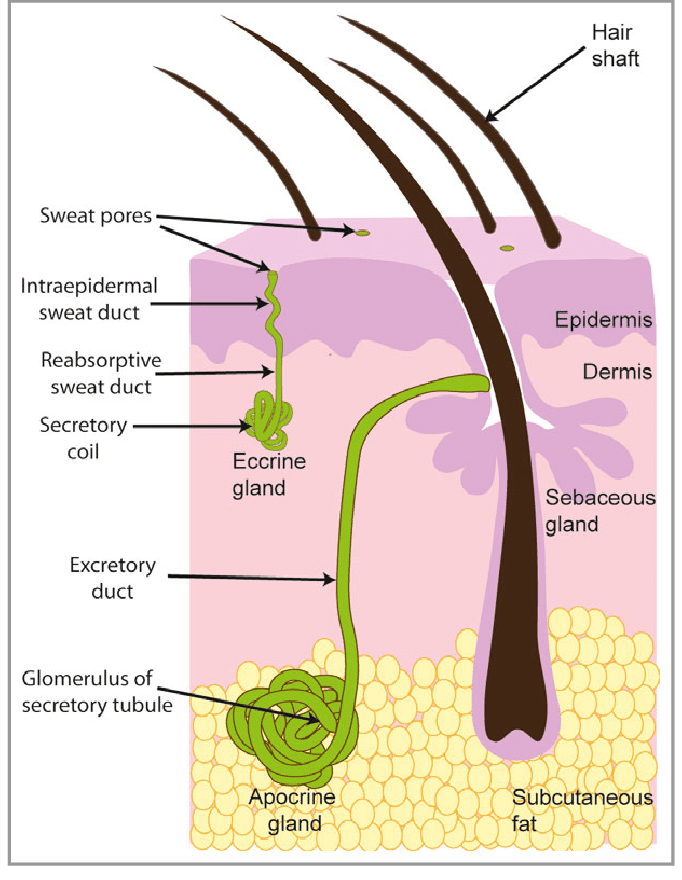
1.Eccrine sweat glands:

- This type of sweat gland is distributed almost everywhere in the body. This sweat gland has a duct. This duct opens on the upper part of the skin and pours the secretion (sweat) of the sweat gland onto the skin. This type of sweat gland is not found in places like the nail bed, vulva, tip of the penis, on the lips, ear drum, etc.
- When the outside environment is hot and the temperature increases, these glands become active and secrete sweat. Which is called the action of perspiration and thus it also works to maintain body temperature.
Composition of Sweat:
- Urea
- Lactic acid
- Albumin
- Fat
- Sodium chloride
- Sugar
- Ascorbic acid
The above components are found in the composition of sweat.
2. Apocrine glands (Apocrine gland):

These glands are located deep in the body. They are inactive before puberty. During puberty, their size increases and they become active. These types of glands are located in places like the axilla, groin, etc. and they also secrete sweat.
Sebaceous glands:
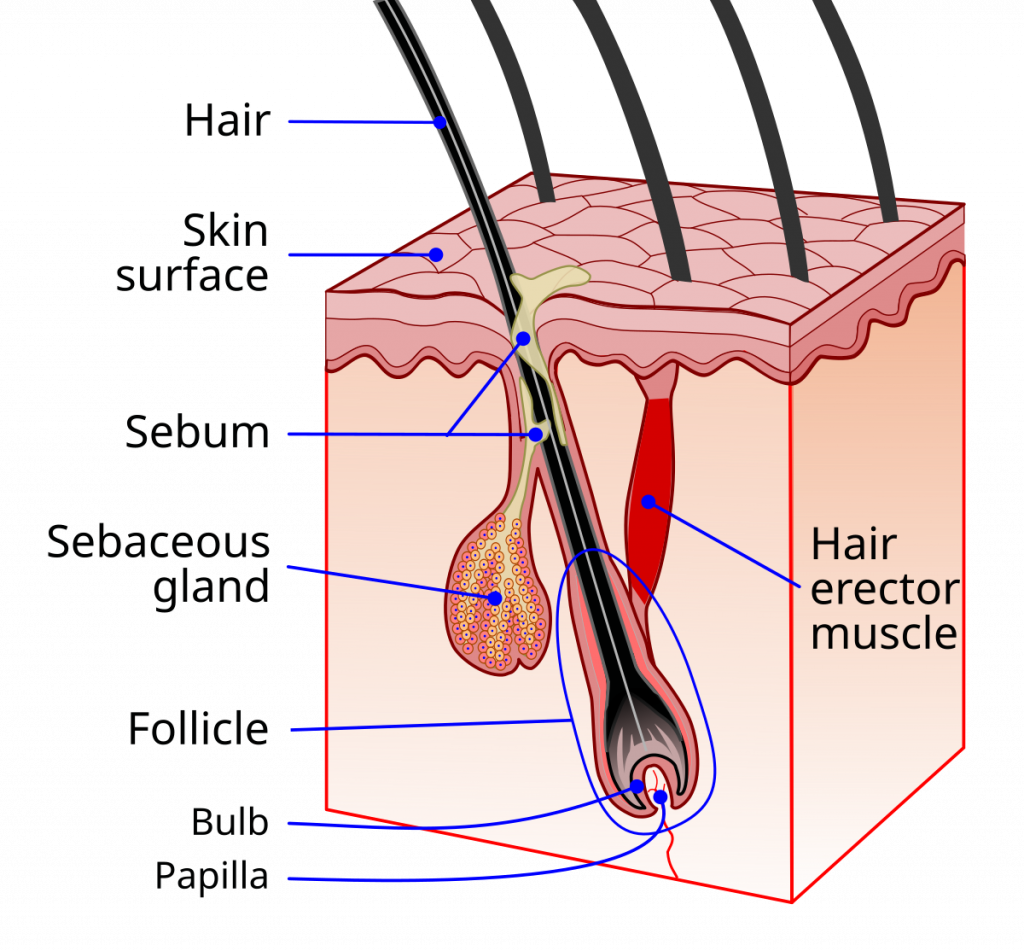
- The sebaceous glands, which are simple structures connected to hair follicles in the dermis layer of the skin, are located.
- The cells in these glands secrete a sticky oil called sebum.
- This sebum is thicker than a liquid. It contains lipid substances.
- This sebum acts as a barrier at the opening of the hair follicle, thus preventing microorganisms from entering the body. Thus it performs a protective function.
It acts as a lubricant and keeps the hair follicle and skin soft.
Structure and Functions of Hair:
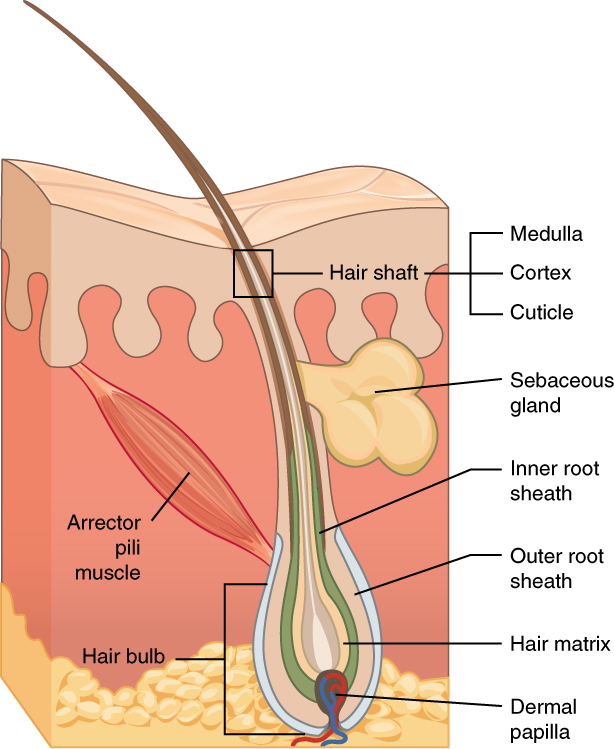
- Hair is a structure of keratinized epithelium tissue. It arises from the dermis layer of the skin and is spread over most of the skin. It lies on the skin like a single layer.
- Hair is not found on the sole of the foot, tip of the penis, vulva and nipple. Apart from that, hair is found almost all over the body.
- Hair is divided into two parts. In which the part that is visible above the skin is called soft of hair and the part that is pressed under the skin is called root of hair.
- There are three layers around the hair. The structural layer at the base is called the papilla of hair or bulb of hair. Which contains blood vessels and provides nutrition to the hair structure for growth.

- On top of it Cortex layer is present. In which melanin is present. Which gives color to the hair. In this layer, matrix germinal is present in the bulb part.
- The topmost layer of the hair is called medulla. It is a layer made of keratin and is loosely woven around the outside.
Functions of hair (Main functions of hair):

- The main function of hair is protection in the body. For example, the hair on the scalp insulates the body from heat and cold.
- The hair on the eyebrows prevents bright light and glare from entering the eyes directly, and helps prevent sweat from going directly into the eyes.
- In addition, it prevents foreign bodies or dust particles from entering the eyes directly. Eye lashes also prevent foreign bodies or dust particles from entering the eyes.
- The hairs in the nostrils moisten and warm the inhaled air and prevent dust particles or foreign material from entering the respiratory tract.
- The secretions of the sebaceous glands that open in the hairs keep the skin lubricated and prevent the skin from drying out.
- Hairs are found around openings in the body such as the anus, vagina, etc. Which are associated with the function of protection.
Structure and function of Nail:
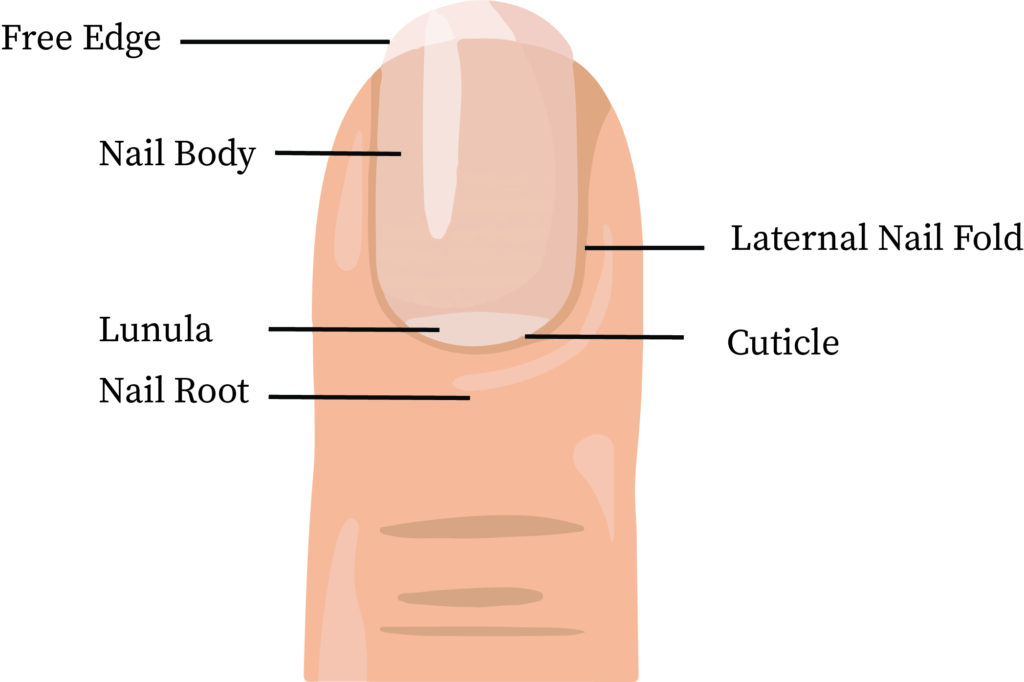
- It is a structure made up of dry keratinized epithelium tissue in the epidermis layer. It is located at the ends of the dorsal surface of the hands and feet. They are made of keratin.
- They appear pink in color because they are spread over the skin, but because the blood supply to the nail bed is low, they do not appear pink.
- The structure of the nail can be described as follows.
- The innermost part of the nail is called the nail root. It is the part that is pressed under the skin. The layer on it is called Eponychium, which covers the nail root.
- The part of the nail that is visible outside is called the nail body. It is made up of keratinized dead cells.
- The part of the nail body that is spread over the epithelium layer of the skin is called the nail bed. The part that extends beyond the skin is called the free edge. It is the part of the finger or toe that extends beyond the skin. It is completely dead cells. Which can be cut and removed.
Functions of Nails:
- Useful for holding or grasping any objects.
- Helpful for scratching or removing any objects.
- Our fingers, toe and thumb Protects the nail.
- It is an indicator for assessing the patient’s clinical condition.
Heat Regulation (Heat Regulation):

Heat is produced in the body through various processes and the excess heat is lost from the body through various mechanisms. The body maintains normal heat i.e. its temperature.
Heat production in the body is done through the following processes.
- Metabolism of food
- Exercise
- Hormones
- Emotions
- Age
The body loses Heat through the following mechanisms.
The excess heat in the body is lost from the body through the skin through the following mechanisms. Mechanism of heat loss can be described as follows.
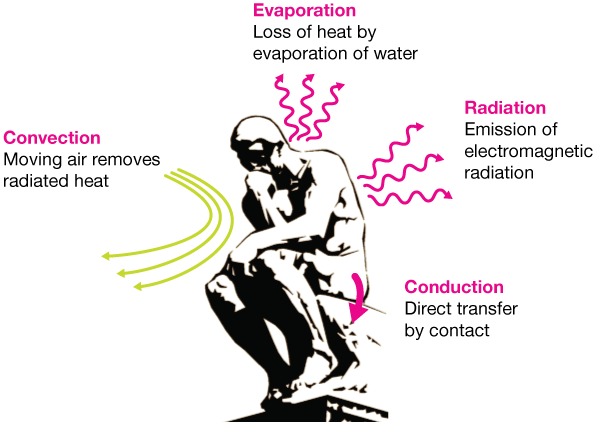
Radiation:
Total from this hit a warm object Transferred to the object. In which there is no physical contact between the two objects. Most of the body’s heat is lost through this mechanism.
Like in summer, heat is transferred to the body through radiation due to excessive exposure to sunlight.
Conduction:
In this mechanism, body heat is transferred from the hot side to the cold side by direct contact. Like coming into contact with a cold surface or cold clothes, body heat is lost. This mechanism causes the least amount of heat loss.
Convection:
In this, heat is lost through the circulating air. As when cold air passes over any body part that is open, heat loss is seen through this mechanism.
Heat loss is seen through this mechanism due to windows, doors or fans being on.
Evaporation:
In this, heat loss is seen from the surface due to the conversion of liquid into vapor. In which, due to perspiration on the body surface, body heat is lost through evaporation.
Thus, through the above method, additional heat loss occurs from the body and the normal temperature of the body is maintained.
The regulation of body temperature also depends on the control of the nervous system, hypothalamus, blood circulation, etc.

